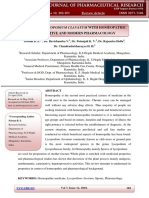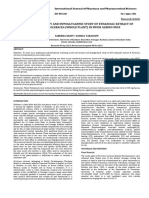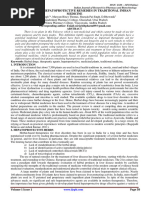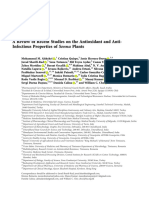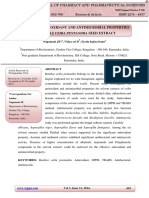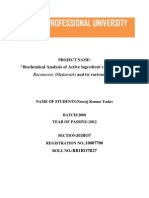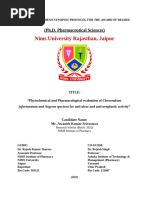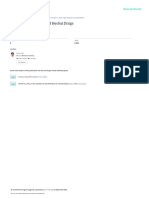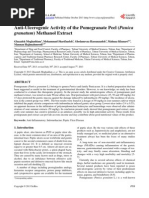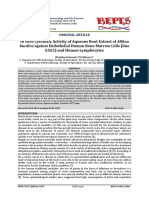Evaluation of Invitro Methods of Antioxidant and Antiulcer Activity of Poly Herbal Plants From North India
Evaluation of Invitro Methods of Antioxidant and Antiulcer Activity of Poly Herbal Plants From North India
Uploaded by
dynamographicCopyright:
Available Formats
Evaluation of Invitro Methods of Antioxidant and Antiulcer Activity of Poly Herbal Plants From North India
Evaluation of Invitro Methods of Antioxidant and Antiulcer Activity of Poly Herbal Plants From North India
Uploaded by
dynamographicOriginal Title
Copyright
Available Formats
Share this document
Did you find this document useful?
Is this content inappropriate?
Copyright:
Available Formats
Evaluation of Invitro Methods of Antioxidant and Antiulcer Activity of Poly Herbal Plants From North India
Evaluation of Invitro Methods of Antioxidant and Antiulcer Activity of Poly Herbal Plants From North India
Uploaded by
dynamographicCopyright:
Available Formats
Evaluation of Invitro Methods of Antioxidant And Antiulcer Activity of Poly Herbal Plants From
North India
Section A-Research paper
Evaluation of Invitro Methods of Antioxidant And
Antiulcer Activity of Poly Herbal Plants From North India
1
Dr. Santosh S. Bansode, 2Mrs.Mhaske Pratiksha Bharat, 3Dr. Mohamed Zerein Fathima,
4
Ms. Soodabeh Delgosha, 5Dr.Jyoti Gorakh Wagh, 6Dr. Ramana Hechhu, 7Mr. Bhagat Suraj Dilip,
8
Mr. Arvinder Pal Singh
1
Dr. Kolpe Institute of Pharmacy, Kolpewadi, Ahmednagar, Maharashtra. Pin code:- 423602
2
Matoshri Radha College of pharmacy virgaon, Ahmednagar, Maharashtra. Pin code:- 422601
3
Department Of Pharmaceutical Chemistry And Analysis, School Of Pharmaceutical Sciences, Vels Institute Of
Science Technology And Advanced Studies, Pallavaram, Channai, Tamilnadu.Pn Cde:-600117
4
Pharmaceutical Science Branch, Tehran Islamic Azad University Of Medical Sciences, Tehran, Iran.
5
MES College of Pharmacy,Sonai, Ahmednagar, Savitribai Phule Pune University, Maharashtra. Pin code:- 414105
6
School of Pharmacy, College of Health Sciences & Medicine, Wolaita Sodo University, Wolaita Sodo, Ethiopia,
7
Tatyaraoji More Collegeof Pharmacy, Umerga, Dharashiv, Maharashtra. Pin code:- 413606
8
Maharaja Agrasen School of Pharmacy, Atal Shiksha Kunj, Kalujanda, Baddi, Solan, H.P. Pin code: 174 103
Corresponding Author
1
Dr. Santosh S. Bansode
1
Dr. Kolpe Institute of Pharmacy, Kolpewadi, Ahmednagar, Maharashtra. Pin code:- 423602
Abstract
Ulcers can be caused by a number of different things in humans, including stress, long-term
use of anti-inflammatory medicines, etc. It is generally acknowledged that ulcer is the
outcome of an imbalance between aggressive factors and maintenance of the mucosal
integrity through the endogenous defense mechanism, even if the origin of ulcer is unknown
in most cases. As a result, scientists are still looking for ways to improve upon existing anti-
ulcer medications by assessing the gastroprotective qualities of various medicinal plants.
Traditional medicine relies on Spondias mombin L and Calpurnia aurea to cure inflammation
and gastrointestinal disorders. The acid-neutralizing capacity (ANC) of the extract was found
to be significantly lower at a concentration of 1500 mg compared to 15.7 with standard
Aluminium hydroxide + Magnesium hydroxide (500mg) when assessing for anti-ulcer
activities using aqueous extract and in-vitro method as the acidneutralizing capacity and
H+/K+ - ATPase inhibition activity method. Maximum percentage inhibition of H+/K+-
ATPase activity was seen with 100 g of extract compared to 69.56% with regular
Omeprazole.
Keywords: Ulcer Activity, Herbal Extract, Omeprazole, Invitro
1985
Eur. Chem. Bull. 2023, 12(Special Issue 4), 1985-1992
Evaluation of Invitro Methods of Antioxidant And Antiulcer Activity of Poly Herbal Plants From
North India
Section A-Research paper
Introduction
Ayurveda is just one of the many ancient medical practises that have been around for a long
time but are still used today. This ancient Vedic knowledge, which is more commonly known
as Ayurvedic Medicine, has been around for a significant amount of time and is frequently
acknowledged as being one of the first medical sciences.[1] Ayurveda, also known as the
"Mother of All Healing," is an ancient Indian medical practise that has been practised for
generations.[2] The term "the science of life" comes from the Sanskrit words "ayur," which
means "life," and "veda," which means "science or knowledge." This field of study focuses
on achieving a state of internal and external equilibrium through a number of different
methods.[3] Herbal remedies have a long and illustrious history that has been well
documented and can be traced back to at least the Stone Age in many parts of the world.
Herbal medicine was practised in ancient China, Greece, Egypt, and India, as well as in
traditional healing rituals practised by Native Americans and Africans.[4] Herbal medicine
was used for a wide variety of therapeutic purposes. A number of ancient Indian texts, such
as the Vedas and the Samhitas, attest to the fact that herbs are among the Ayurvedic system's
most powerful active pharmaceutical components. At the beginning of the 19th century,
scientists began to isolate and modify active compounds found in herbal remedies using
newly developed chemical analysis tools.[5-6] These procedures were performed on herbal
remedies. This marked the beginning of a transition away from using natural medicinal herbs
and towards using synthetic pharmaceuticals. During this time, there was a gradual shift away
from the use of herbal remedies.According to the findings of a study [7], despite having a
potent pharmacological effect, synthetic drugs are more expensive than their natural
counterparts and have a greater number of unintended side effects. Peptic ulcer disease has
become the focus of both laboratory and clinical investigations in recent years [8] as a direct
result of the disease's high incidence rate among people all over the world. Peptic ulcer is a
problem in the public health system that has a high prevalence of morbidity and a significant
mortality rate. Peptic ulcers are commonly caused when there is an imbalance in the
stomach's destructive and protective components [9]. Exogenous factors include excessive
alcohol consumption, indiscriminate use of NSAIDs, stress, smoking, and an infection with
Helicobacter pylori. Endogenous factors include HCl, pepsin, biliary reflux, lipid
peroxidation, and the creation of active oxygen species (ROS) [10]. The mucus-bicarbonate
barrier, mucin synthesis, surface phospholipids, prostaglandins (PGs), nitric oxide (NO),
mucosal blood flow, cell renewal, growth factors, and antioxidant enzymes are all
components of the defence system [11]. Oxidative stress brought on by gastric ulceration
causes an increase in the formation of reactive oxygen species (ROS), which has the potential
to compromise the epithelial cells' ability to maintain their integrity. An abnormally high
production of ROS metabolites has the potential to compromise the natural antioxidant
defences of the body [12]. In addition, reactive oxygen species encourage the accumulation
of neutrophils in mucosal tissues when gastric ulceration is present. Recent studies [13,14]
have shown that the damage caused by ulcers is significantly exacerbated by
proinflammatory cytokines, which are responsible for activating neutrophils. Peptic ulcers
can be effectively treated with substitutes that control acidic hypersecretion and its immediate
1986
Eur. Chem. Bull. 2023, 12(Special Issue 4), 1985-1992
Evaluation of Invitro Methods of Antioxidant And Antiulcer Activity of Poly Herbal Plants From
North India
Section A-Research paper
effects on the mucosa of the stomach.[15-16] There are primarily two different kinds of
medications that can be used to treat the symptoms that are brought on by acid.
Material & Methods:
We obtained two of the polyherbal plants under study, Spondias mombin L and Calpurnia
aurea, from the forest research institute's central nursery in Dehradun, India.
Extract Process
After being allowed to air-dry for fourteen days at room temperature and in the shade, the
leaves of Spondias mombin L and Calpurnia aurea were ground into a coarse powder. After
that, 600 grammes of powder needed to be macerated with 80 percent methanol in a conical
flask using a micro orbital shaker for a total of three days. On day three, we used gauze to
separate the supernatant from the marc, and then we filtered the mixture through Whatman No.
1 filter paper to remove any remaining impurities. The remaining residue was macerated once
more for a total of six days in the same solvent that had been used for the first two macerations.
After being combined, the supernatant from each succeeding filter was dried in a hot oven set
to 40 degrees Celsius, and then lyophilized to remove any remaining moisture. After
calculating and recording the yield percentage, it was placed in a plastic desiccator for
safekeeping [18]. The procedure described in Ayal et al. [18] was altered slightly so that the
hydromethanolic extract could be further fractionated with the aid of ethyl acetate, chloroform,
and distilled water. In a separatory funnel, 80 grammes of extract were diluted with 360
millilitres of distilled water, and then 360 millilitres of chloroform were partitioned through
three times. This process was repeated twice. Condensation of the precipitate was then carried
out in an oven at a temperature of 40 degrees Celsius and a pressure of 30 millibars in order to
obtain the chloroform fraction. The remainder was segmented into three equal parts by using
the same volume of ethyl acetate in each step. In a process that was very similar to the one that
was used to dry the chloroform fraction, the filtrates were placed in a hot oven and allowed to
dry. After leaving the remaining aqueous fraction to lyophilize for the night, the yields of each
of the different fractions were calculated using a percent system. After that, the components
were placed in an airtight container and kept at a temperature of 4 degrees Celsius until they
were required for the research. Tannins, saponins, flavonoids, alkaloids, phenols, glycosides,
steroids, and terpenoids were discovered as a result of confirmatory qualitative phytochemical
screening of plant extracts using well-established methods.
Test for Tannins
With the addition of 0.1% ferric chloride, 200 mg of the plant extract was heated with 10 mL of
distilled water. The liquid was then examined for blue-black colouring, which would indicate
the presence of tannins.
1987
Eur. Chem. Bull. 2023, 12(Special Issue 4), 1985-1992
Evaluation of Invitro Methods of Antioxidant And Antiulcer Activity of Poly Herbal Plants From
North India
Section A-Research paper
Test for Alkaloids
100 mL of water was used to dissolve the plant extract, which was then filtered before being
boiled in steam with 2 mL of the filtrate and 3 drops of 1% HCl. The Mayer-Wagner reagent
was then added to 1 mL of the heated mixture. Alkaloids could be detected by the formation of
a cream- or brown-red coloured precipitate.
Test for Saponins
The extract was mixed with 5 mL of distilled water and 0.5 mL of agitated. The appearance of
saponins was then confirmed by the creation of foam.
Test for Flavonoids and Glycosides
After being combined with 10 mL of ethanol, 200 mg of the plant extract was filtrated.
Magnesium ribbon, concentrated HCl, and filtrate were combined in two mL. Pink or red
colour formation suggests the presence of flavonoids. When 0.5 mL of crude extract was mixed
with 1 mL of distilled water and 1 mL of NaOH, the appearance of a yellowish colour showed
the existence of glycosides.
Test for Steroids
The presence of steroids is demonstrated by the creation of a bilayer (red top layer and greenish
bottom layer) after 1 mL of the crude extract was mixed with 10 mL of chloroform and 10 mL
of sulfuric acid.
Test for Terpenoids
The production of a reddish-brown colour in the terpenoids test, which involved combining 0.5
mL of crude extract with 2 mL of chloroform and 3 mL of sulfuric acid, indicated the presence
of terpenoids.
Test for Phenols
Three drops of FeCl3 and one millilitre of K2Fe (CN6) were added to around 1 mL of the
extract. The development of greenish-blue forms proved that phenols were present.
DPPH radical scavenging assay
The ability of the extracts to neutralise free radicals was determined by carrying out an
experiment known as the DPPH radical scavenging assay, which was outlined by Blois [23]
and Desmarchelier et al. [24]. The decolorization of a methanol solution of 2,2-diphenyl-1-
picrylhydrazyl (DPPH) was used to evaluate the plant extractives' capacity to donate
hydrogen atoms. DPPH is an acronym for 2,2-diphenyl-1-picrylhydrazyl. In a solution of
methanol, DPPH produces a colour that can be described as violet or purple. This colour,
1988
Eur. Chem. Bull. 2023, 12(Special Issue 4), 1985-1992
Evaluation of Invitro Methods of Antioxidant And Antiulcer Activity of Poly Herbal Plants From
North India
Section A-Research paper
however, changes to varying shades of yellow when antioxidants are present. Following the
formation of a solution by dissolving 0.1 mM DPPH in methanol to form a solution, 2.4 mL
of this solution was then added to 1.6 mL of extract in methanol at various concentrations
ranging from 12.5 to 150 g/mL. After complete agitation with the vortex, the reaction mixture
was left to sit at room temperature and out of the light for half an hour. Using
spectrophotometry, the absorbance of the mixture was measured at a wavelength of 517 nm.
The benchmark that was used was BHT. For the purpose of computing the percentage of
DPPH radical scavenging activity, the following equation was utilised:
where the absorbance of the containing or standard is denoted by A1, and the absorbance of
the control is denoted by A0. After that, a graph was created in which the concentration was
compared to the percentage of inhibition, and the IC50 was calculated using the graph. The
experiment was carried out three times, each time with a different concentration.
In-vitro Ant-ulcer Activity
Preparation of H+/K+ - ATPase Enzyme: Percentage of inhibition = [Activity (Control)-
Activity test / Activity(Control)] x 100
Result & Discussion
In order to prepare the fresh goat stomach that had been purchased from the local butcher, the
gastric mucosa of the fundus was cut off and opened, and the inner layer of the stomach was
scraped out for the parietal cell. This was done in order to prepare the stomach for the parietal
cell. After homogenising the stomach parietal cell in a Tris buffer containing 16 mM and
having a pH of 7.4, as well as 10% Triton X-100, the mixture was centrifuged at 6000 rpm
for ten minutes. After that, the solution in the supernatant was put to use to inhibit H+/K+
ATPase. The amount of protein can be calculated using Bradford's method, and the BSA
value serves as a point of comparison. An analysis of the inhibition of the H+/K+ ATPase
The reaction mixture of the sample that contained 0.1 ml of enzyme extract (300 g) and plant
extract at various concentrations was per-incubated for 60 minutes at 37 degrees Celsius. The
concentrations of the plant extract were as follows: 20 g, 40 g, 60 g, 80 g, and 100 g. As the
substrate, 2 mM ATP was added to the mixture, as well as 200 mL each of 2 mM MgCl2 and
10 mL each of KCl, all of which were added in order to initiate the reaction. The reaction was
terminated with 4.5% ammonium molybdate after being carried out for 30 minutes at 37
degrees Celsius. The mixture was then centrifuged at 2000 rpm for ten minutes to separate
the inorganic phosphate, which was then measured at 660 nm using the Fiske-Subbarow
technique. Next, 60% perchloric acid was added to the mixture. In a nutshell, after ten
minutes at room temperature, 0.4 millilitres of ANSA, 1 millilitre of 2.5% ammonium
molybdate, 4 millilitres of Millipore water, and one millilitre of supernatant were added. The
absorbance of inorganic phosphate at 660 nm has been measured at various extract doses, and
the enzyme activity has been calculated as the amount of Pi that is released in micromoles per
hour. The results were analysed and compared to omeprazole, a well-known anti-ulcer PPA
1989
Eur. Chem. Bull. 2023, 12(Special Issue 4), 1985-1992
Evaluation of Invitro Methods of Antioxidant And Antiulcer Activity of Poly Herbal Plants From
North India
Section A-Research paper
inhibitor. The results were expressed as Mean SEM. After applying the formula, it was
determined that there was a 16% inhibition of the enzyme.
Table:1 Phytochemical Analysis
Methanol Solvent
Test Spondias mombin L Calpurnia aurea
Flavonoids + +
Alkaloids + +
Saponins + +
Glycosides + -
Carbohydrates + +
Steroids + -
Tannins - -
Triterpenoids - +
DPPH Radical Scavenging Assay
The data from Table 2 and Figure 1 show that the combination has the highest levels of
DPPH. The data was gathered from the percentage of inhibition. The results were evaluated
in comparison to the standard practise of using ascorbic acid. A higher percentage of
inhibition is indicative of greater scavenging activity or antioxidant potential. The findings
were statistically significant, as determined by a p-value of 0.05.
Fig: 1 Antioxidant activity of Poly herbal formulation
1990
Eur. Chem. Bull. 2023, 12(Special Issue 4), 1985-1992
Evaluation of Invitro Methods of Antioxidant And Antiulcer Activity of Poly Herbal Plants From
North India
Section A-Research paper
Table 2 DPPH Activity of Polyherbal formulation
S.No Concentration Ascorbic acid % Polyherbal Formulation% inhibition
inhibition
1 12.5 38.74 26.12
2 25 41.87 44.65
3 50 61.97 68.14
4 100 64.79 68.47
5 200 66.98 76.78
6 400 72.56 81.45
IC50 10.97 36.71
H+/K+ - ATPase Enzyme:
At different concentrations (20g, 40g, 60g, 80g, and 100g), the H+/K+ - ATPase inhibition
activity of the aqueous extract was evaluated and contrasted with that of omeprazole, which
served as the gold standard. The extract exhibited significant activity that varied significantly
with the dose. In comparison to the standard Omeprazole, the extract demonstrated the
highest percentage inhibition (62.18 0.54%) when it was present at a concentration of 100 g.
At different concentrations (20g, 40g, 60g, 80g, and 100g), the H+/K+ - ATPase inhibition
activity of the aqueous extract was evaluated and contrasted with that of omeprazole, which
served as the gold standard. The extract exhibited significant activity that varied significantly
with the dose. At a concentration of 100g, the extract had a maximum percentage inhibition
of 62.180.54%, while the standard omeprazole had a maximum percentage inhibition of
69.561.72%. The findings of the study are presented in Figure 2.
5
% Inhibition
4 Standard
3 Control
polyherbal formulation
2
0
20 40 60 80 100
Concentration μg
FIG: 2 H+/K+ - ATPASE INHIBITION ACTIVITY OF METHANOLIC EXTRACT
IN VITRO
1991
Eur. Chem. Bull. 2023, 12(Special Issue 4), 1985-1992
Evaluation of Invitro Methods of Antioxidant And Antiulcer Activity of Poly Herbal Plants From
North India
Section A-Research paper
Conclusion
H+-K+ The enzyme ATPase is located on the partial cell's apical secretory membrane. For
the treatment of ulcers, there are many medications like PPIs, H2 blockers, etc., but because
they have interactions and side effects, it is necessary to produce herbal medications using
cutting-edge technology to create effective medications with fewer side effects. In the current
study, extracts and omeprazole both inhibited the enzyme in a dose-dependent manner.
Methanolic extract significantly demonstrated better inhibition than chloroform extract.
References
1. Das, S., Singh, V. D., Bind, A., Anamika, A., Gupta, S. P., & Kumar, R. (2022). Evaluation of
antiulcer, antioxidant potency of manuka honey and cinnamon powder mixture in Wistar rats
using experimental rat models. International Journal of Health Sciences, 6(S6), 6259–6268.
https://doi.org/10.53730/ijhs.v6nS6.10979
2. Afzaal, M., Saeed, F., Ateeq, H., Akhtar, M. N., Imran, A., Ahmed, A., ... & Awuchi, C. G. (2023). Probiotics encapsulated
gastroprotective cross‐linked microgels: Enhanced viability under stressed conditions with dried apple carrier. Food Science &
Nutrition, 11(2), 817-827.
3. Afzaal, M., Saeed, F., Ateeq, H., Akhtar, M. N., Imran, A., Ahmed, A., ... & Awuchi, C. G. (2022). Probiotics encapsulated
gastroprotective cross-linked microgels: Enhanced viability under stressed conditions with dried apple carrier.
4. Kumar, R., Saha, P., Kahwa, I., Boateng, E. A., Boateng, P. O., & Nyarko, R. O. (2022). Biological Mode of Action of Phospholipase
A and the Signalling and Pro and Anti Inflammatory Cytokines: A Review. Journal of Advances in Medicine and Medical
Research, 34(9), 1-10.
5. Mishra, A., Singh, Y., Singh, R., Kumar, R., Shukla, S., Kumar, R., ... & Pol, S. L. (2022). Ethano-pharmacology activity &
Antioxidant activity of Centella asiatica Plant Parts. NEUROQUANTOLOGY, 20(11), 7562-2.
6. Singhal, A. K. V., Giri, S., & Kumar, R. (2022). INVESTIGATION OF IN-VITRO ANTI-OXIDANT & ANTI-ULCER ACTIVITY
OF ANGIOGENESIS LATIFOLIA ROXB (DHAVA). NeuroQuantology, 20(11), 5680-5686.
7. Chaudhary, H., Sagar, S., Kumar, R., Bisht, V., & Butola, K. (2022). Herbal Essential Oil use as Ulcer Protective Activity: A
Systematic Review. Journal for Research in Applied Sciences and Biotechnology, 1(5), 86-101.
8. Prajapati, A. K., Sagar, S., & Kumar, R. (2022). Past and Current Prospectives of Herbal Product for Skin Care. Journal for Research
in Applied Sciences and Biotechnology, 1(5), 145-160.
9. Kumar, R., Singh, A., & Painuly, N. (2022). Investigation of in-vitro anti-oxidant & anti-ulcer activity of polyherbal medicinal
plants. Journal of Pharmaceutical Negative Results, 2077-2088.
10. Awuchi, C. G., Saha, P., Amle, V. S., Nyarko, R. O., Kumar, R., Boateng, E. A., ... & Asum, C. (2023). A Study of Various Medicinal
Plants used in Ulcer Treatment: A Review. Journal for Research in Applied Sciences and Biotechnology, 2(1), 234-246.
11. Kohli, A., & Kumar, R. (2023). Role of Antioxidants of Natural Herbs in Management of Male Infertility. Journal for Research in
Applied Sciences and Biotechnology, 2(1), 55-80.
12. Kumar, R., & Saha, P. (2022). A review on artificial intelligence and machine learning to improve cancer management and drug
discovery. International Journal for Research in Applied Sciences and Biotechnology, 9(3), 149-156.
13. Patel, R. K., Gangwar, D., Gupta, H., Sharma, N., & Kumar, R. (2023). Plants Alkaloids Based Compound as Therapeutic Potential for
Neurodegenerative. Journal for Research in Applied Sciences and Biotechnology, 2(2), 14-26.
14. Bind, A., Das, S., Singh, V. D., Kumar, R., Chourasia, A., & Saha, P. (2020). Natural Bioactives For The Potential Management Of
Gastric Ulceration. Turkish Journal of Physiotherapy and Rehabilitation, 32(3), 221-226
15. Saha, P., Kumar, R., Nyarko, R. O., Kahwa, I., & Owusu, P. (2021). Herbal Secondary Metabolite For Gastro-Protective Ulcer
Activity With Api Structures.
16. Kumar, R., Saha, P., Kahwa, I., Boateng, E. A., Boateng, P. O., & Nyarko, R. O. (2022). Biological Mode of Action of Phospholipase
A and the Signalling and Pro and Anti Inflammatory Cytokines: A Review. Journal of Advances in Medicine and Medical
Research, 34(9), 1-10.
1992
Eur. Chem. Bull. 2023, 12(Special Issue 4), 1985-1992
You might also like
- EVM For Pet Animals by Dr. Elamaran.ADocument7 pagesEVM For Pet Animals by Dr. Elamaran.Aelanthamizhmaran100% (1)
- Research ArticleDocument8 pagesResearch Articlebalaji govindNo ratings yet
- Research Paper 3 (2024)Document9 pagesResearch Paper 3 (2024)arghya pariaNo ratings yet
- Lycopodium 7Document6 pagesLycopodium 7muhammad aminNo ratings yet
- Synopsis 119997290053 (1)Document17 pagesSynopsis 119997290053 (1)avika11tiwariNo ratings yet
- CissampelosPareira PDFDocument14 pagesCissampelosPareira PDFsurendra Prasad GuptaNo ratings yet
- Research Article: Phytochemical Screening and Acute Oral Toxicity Study of Java Tea Leaf ExtractsDocument9 pagesResearch Article: Phytochemical Screening and Acute Oral Toxicity Study of Java Tea Leaf ExtractsAsad SaleemNo ratings yet
- Antibacterial Activity Screening of Few Medicinal Plants From The Southern Region of IndiaDocument4 pagesAntibacterial Activity Screening of Few Medicinal Plants From The Southern Region of IndiaDr. Varaprasad BobbaralaNo ratings yet
- A Study On The Bioefficacy of L.: Volume 6, Issue 4, 1381-1398. Research Article ISSN 2277 - 7105Document18 pagesA Study On The Bioefficacy of L.: Volume 6, Issue 4, 1381-1398. Research Article ISSN 2277 - 7105Ichigo IchieNo ratings yet
- 7959Document5 pages7959Ashique RajputNo ratings yet
- Antifungal Anti Inflammatory and GC MS ADocument8 pagesAntifungal Anti Inflammatory and GC MS ATrevens uiNo ratings yet
- Sushmita 9Document11 pagesSushmita 9Sushmita ChoudhuryNo ratings yet
- Evaluation of Antimicrobial and Antioxidant Activity of Crude Methanol Extract and Its Fractions of Mussaenda Philippica LeavesDocument14 pagesEvaluation of Antimicrobial and Antioxidant Activity of Crude Methanol Extract and Its Fractions of Mussaenda Philippica Leavesiaset123No ratings yet
- Chewable Tablet of GingerDocument9 pagesChewable Tablet of GingerMahewash PathanNo ratings yet
- Article H PyloriDocument16 pagesArticle H PyloriketavmodiNo ratings yet
- Use of Medicinal Plants in Oral LesionsDocument5 pagesUse of Medicinal Plants in Oral LesionsPela Minha SaúdeNo ratings yet
- Plants Used in Hepatoprotective Remedies in Traditional Indian MedicineDocument6 pagesPlants Used in Hepatoprotective Remedies in Traditional Indian Medicineprachichanyal1No ratings yet
- A Review of Recent Studies On The Antioxidant andDocument38 pagesA Review of Recent Studies On The Antioxidant andnoor.ahmed1No ratings yet
- In Vitro Anti Microbial Activity of Leaf Powder: ResearchDocument4 pagesIn Vitro Anti Microbial Activity of Leaf Powder: ResearchLa Ode Muhammad FitrawanNo ratings yet
- Renny Et AlDocument7 pagesRenny Et AlTatas BrotosudarmoNo ratings yet
- Mini Project FINAL (25 Pages) Pranu (1) 007Document28 pagesMini Project FINAL (25 Pages) Pranu (1) 007ghiasuddin786786No ratings yet
- Mistry 139-150Document12 pagesMistry 139-150Rajesh KumarNo ratings yet
- 2012 Bipin Journal of Pharmacy ResearchDocument2 pages2012 Bipin Journal of Pharmacy ResearchStephen MooreNo ratings yet
- 438-Article Text-851-1-10-20200722Document6 pages438-Article Text-851-1-10-20200722Faizan RashidNo ratings yet
- Article Wjpps 1417420727Document15 pagesArticle Wjpps 1417420727Muhammad BilalNo ratings yet
- Vol3 Issue5 03Document5 pagesVol3 Issue5 03R.G.ManikarajanNo ratings yet
- Jayarama Reddy, Gnanasekaran D., Vijay D. and Ranganathan T.VDocument10 pagesJayarama Reddy, Gnanasekaran D., Vijay D. and Ranganathan T.VPadmanabha GowdaNo ratings yet
- The Quest For Evidence Based AyurvedaDocument12 pagesThe Quest For Evidence Based Ayurvedaayurveda2011No ratings yet
- The Quest For Evidence-Based Ayurveda: Lessons Learned: Bhushan PatwardhanDocument13 pagesThe Quest For Evidence-Based Ayurveda: Lessons Learned: Bhushan PatwardhanJase HarrisonNo ratings yet
- Pharmacological Efficacy of Argemone Mexicana PlantDocument9 pagesPharmacological Efficacy of Argemone Mexicana Plantmayzagal14No ratings yet
- A Review On Electrohomeopathic Medicinal Practice: Origin, Principles, Medicinal Plants Used and Its Current Status in IndiaDocument18 pagesA Review On Electrohomeopathic Medicinal Practice: Origin, Principles, Medicinal Plants Used and Its Current Status in IndiaNaidu VegiNo ratings yet
- Practical Guidebook Pharmacology and ToxicologyDocument107 pagesPractical Guidebook Pharmacology and ToxicologySamad KaziNo ratings yet
- Biochemical Analysis of Active Ingredient's in Asparagus Racemosus (Shatavari) and Its Various UsesDocument27 pagesBiochemical Analysis of Active Ingredient's in Asparagus Racemosus (Shatavari) and Its Various UsesNJ Born To Rule100% (2)
- Template For Research PresentationDocument17 pagesTemplate For Research PresentationmanjuNo ratings yet
- Antioxidant Activity of Methanol Extract of Pandanus Fascicularis LamDocument10 pagesAntioxidant Activity of Methanol Extract of Pandanus Fascicularis LamHương NgNo ratings yet
- PapersDocument7 pagesPapersmasudmiazi169588No ratings yet
- And Aqueous Extracts of Anogeissus Latifolia LeavesDocument8 pagesAnd Aqueous Extracts of Anogeissus Latifolia LeavesvinayNo ratings yet
- Awanish Synopsis Final FebDocument18 pagesAwanish Synopsis Final FebAwanish SrivastavaNo ratings yet
- A Review On Electrohomeopathic Medicinal Practice: Origin, Principles, Medicinal Plants Used and Its Current Status in IndiaDocument18 pagesA Review On Electrohomeopathic Medicinal Practice: Origin, Principles, Medicinal Plants Used and Its Current Status in Indiamalikans1No ratings yet
- PharmacognRes 14-2-107Document8 pagesPharmacognRes 14-2-107Lokesh ChowdaryNo ratings yet
- Jurnal SarvaiyaDocument7 pagesJurnal SarvaiyaSeruni PujanggaNo ratings yet
- Antioxidant Activity and Hepatoprotective Potential of Polyalthia Longifolia and Cassia Spectabilis Leaves Against Paracetamol-Induced Liver InjuryDocument11 pagesAntioxidant Activity and Hepatoprotective Potential of Polyalthia Longifolia and Cassia Spectabilis Leaves Against Paracetamol-Induced Liver InjuryUniversity Malaya's Dental Sciences ResearchNo ratings yet
- Formulation and Evaluation of Antiseptic Polyherbal OintmentDocument11 pagesFormulation and Evaluation of Antiseptic Polyherbal OintmentandrapradeshsseNo ratings yet
- Pharmacological Activity Investigation oDocument5 pagesPharmacological Activity Investigation oMargaux TababaNo ratings yet
- 4 11Document8 pages4 11Deepshikha Be GoodNo ratings yet
- Antidiabetic Effect of Potential Indian Medicinal Plants: A Target Specific In-Vitro StudyDocument14 pagesAntidiabetic Effect of Potential Indian Medicinal Plants: A Target Specific In-Vitro StudyRajendra YegnambhatlaNo ratings yet
- Quali Quanti PhytochemAnalysisDocument7 pagesQuali Quanti PhytochemAnalysisCamille FloresNo ratings yet
- GC-MS Analysis of Phytoconstituents From Amomum Nilgiricum and Molecular Docking Interactions of Bioactive Serverogenin Acetate With Target ProteinsDocument23 pagesGC-MS Analysis of Phytoconstituents From Amomum Nilgiricum and Molecular Docking Interactions of Bioactive Serverogenin Acetate With Target ProteinsarshathNo ratings yet
- Phytochemical Screening of Malaxis Musciferaroot ExtractDocument4 pagesPhytochemical Screening of Malaxis Musciferaroot ExtractIJAR JOURNALNo ratings yet
- Book ChapterDocument21 pagesBook ChapterHaftamuNo ratings yet
- ANti OxidantDocument23 pagesANti OxidantRana Subhi AlkurdNo ratings yet
- P. FoetidaDocument9 pagesP. FoetidaAmadala Rose RiegoNo ratings yet
- Anti Plasmaodium UGDocument13 pagesAnti Plasmaodium UGvijay mNo ratings yet
- 2013 Anti-Ulcerogenic Activity of The Pomegranate Peel (Punica Granatum) Methanol ExtractDocument6 pages2013 Anti-Ulcerogenic Activity of The Pomegranate Peel (Punica Granatum) Methanol ExtractJorge Hantar Touma LazoNo ratings yet
- Perbandingan IC50Document7 pagesPerbandingan IC50luluNo ratings yet
- Anti-Streptococcus Pyogenes Activity of Selected Medicinal Plant Extracts Used in Thai Traditional Medicine.Document6 pagesAnti-Streptococcus Pyogenes Activity of Selected Medicinal Plant Extracts Used in Thai Traditional Medicine.Gregory KalonaNo ratings yet
- Amalraj 2016Document14 pagesAmalraj 2016prasannaNo ratings yet
- 1677 PDFGVFGVVGHG, GHJGGHGHGDocument8 pages1677 PDFGVFGVVGHG, GHJGGHGHGyudit setiawanNo ratings yet
- Kokum (Garcinia Indica) and Its Many Functional Components As Related To The Human Health: A ReviewDocument13 pagesKokum (Garcinia Indica) and Its Many Functional Components As Related To The Human Health: A ReviewSandeep KulkarniNo ratings yet
- Literature Review On Herbal RemediesDocument6 pagesLiterature Review On Herbal Remediesafmzswxbbbbitf100% (2)
- Apothecary For The HomeDocument5 pagesApothecary For The HomeKelsey LeNo ratings yet
- Ethnopharmacology - A Novel Approach For-NewDocument4 pagesEthnopharmacology - A Novel Approach For-NewAle GonzagaNo ratings yet
- Prosea 12.1 Medicinal and Poisonous Plants 1Document708 pagesProsea 12.1 Medicinal and Poisonous Plants 1Fariz Fadhlillah ImaniNo ratings yet
- Herbs Used As Analgesic by Dayak Tribe in North Kalimantan Indonesia Irma Novrianti, Faizal Mustamin, SuharjonoDocument11 pagesHerbs Used As Analgesic by Dayak Tribe in North Kalimantan Indonesia Irma Novrianti, Faizal Mustamin, SuharjonoGandhi NapitupuluNo ratings yet
- Initial Assessment and Treatment Record Template v001 2017-03-01Document3 pagesInitial Assessment and Treatment Record Template v001 2017-03-01Juny WNo ratings yet
- Plant Healer 2020 Herbal Education Guide & Schools DirectoryDocument81 pagesPlant Healer 2020 Herbal Education Guide & Schools DirectoryStacey Diane100% (2)
- EPW 2004 Local - Knowledge - For - World - MarketDocument5 pagesEPW 2004 Local - Knowledge - For - World - MarketMadhulika BanerjeeNo ratings yet
- Alternative TherapiesDocument18 pagesAlternative TherapiesKathlene GamitNo ratings yet
- Power Point Consumer Health EducationDocument81 pagesPower Point Consumer Health EducationAlbert Ian CasugaNo ratings yet
- Pharmacology Herbal MedicinesDocument28 pagesPharmacology Herbal MedicinesMaurice Ann MarquezNo ratings yet
- Training Session #2 - Extraction of The Salt PrincipleDocument10 pagesTraining Session #2 - Extraction of The Salt PrincipleIveri Aura100% (1)
- Ayurveda and Traditional Chinese Medicine: A Comparative OverviewDocument9 pagesAyurveda and Traditional Chinese Medicine: A Comparative OverviewThofanNo ratings yet
- VibhorDocument21 pagesVibhorNeha ShuklaNo ratings yet
- Endophytes From Malaysian Medicinal Plants As Sources For Discovering Anticancer AgentsDocument23 pagesEndophytes From Malaysian Medicinal Plants As Sources For Discovering Anticancer AgentsSantri Akhir ZamanNo ratings yet
- Introduction of Nanotechnology in Herbal Drugs and Nutraceutical Areview 2155 983X 1000143Document8 pagesIntroduction of Nanotechnology in Herbal Drugs and Nutraceutical Areview 2155 983X 1000143Rajanikar KandikondaNo ratings yet
- Cam TherapyDocument31 pagesCam TherapyHemant100% (1)
- Amba HaldiDocument7 pagesAmba HaldibharatNo ratings yet
- Formulation and Evaluation of Herbal Hair Oil: Volume 6, Issue 5 Sep-Oct 2021, PP: 1285-1299Document19 pagesFormulation and Evaluation of Herbal Hair Oil: Volume 6, Issue 5 Sep-Oct 2021, PP: 1285-1299Jaiprakash YadavNo ratings yet
- Chinese Herbal Legends - 50 Stories For Understanding Chinese HerbsDocument262 pagesChinese Herbal Legends - 50 Stories For Understanding Chinese HerbsSergi SalabertNo ratings yet
- Kollaetal PDFDocument13 pagesKollaetal PDFDnyaneshwar Dattatraya PhadatareNo ratings yet
- A Review On Artabotrys Odoratissimus (Annonaceae) : Saritha Kodithala and R MuraliDocument3 pagesA Review On Artabotrys Odoratissimus (Annonaceae) : Saritha Kodithala and R Muralikhaingminaye.tkmmNo ratings yet
- AICTE Sponsored SCOPE Conference Proceedings PDFDocument186 pagesAICTE Sponsored SCOPE Conference Proceedings PDFPustaka Helvetia100% (1)
- Semantic Project FFDocument11 pagesSemantic Project FFHabtamu AlebelNo ratings yet
- Module 2 Lesson 1Document16 pagesModule 2 Lesson 1Chlea Marie Tañedo Abucejo90% (10)
- A Industrial Training ReportDocument23 pagesA Industrial Training ReportSuzan patelNo ratings yet
- 9781441185808 (1)Document369 pages9781441185808 (1)AzizaNo ratings yet
- Picky Eating Guide Healing With HopeDocument25 pagesPicky Eating Guide Healing With Hopefca0502100% (1)



